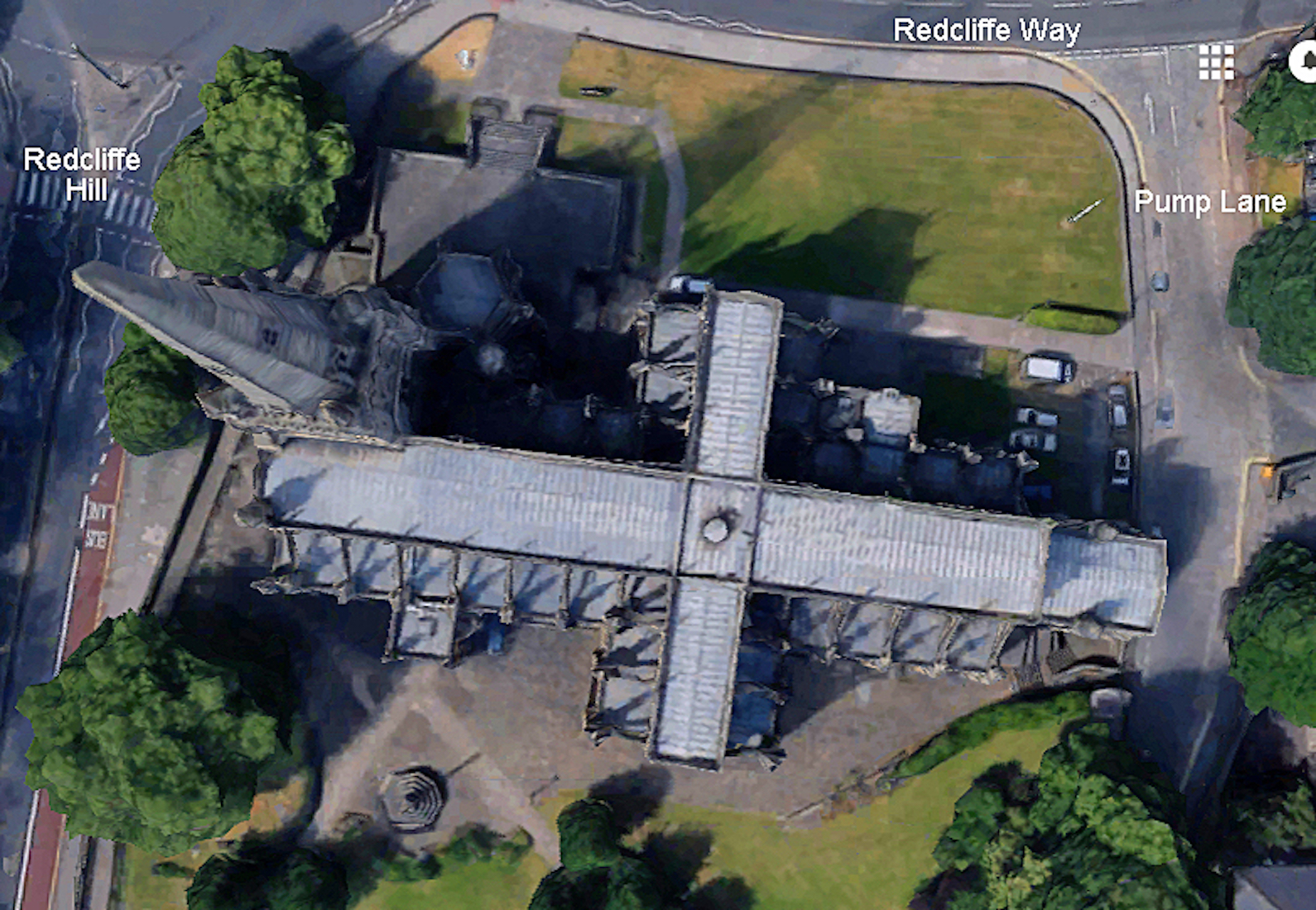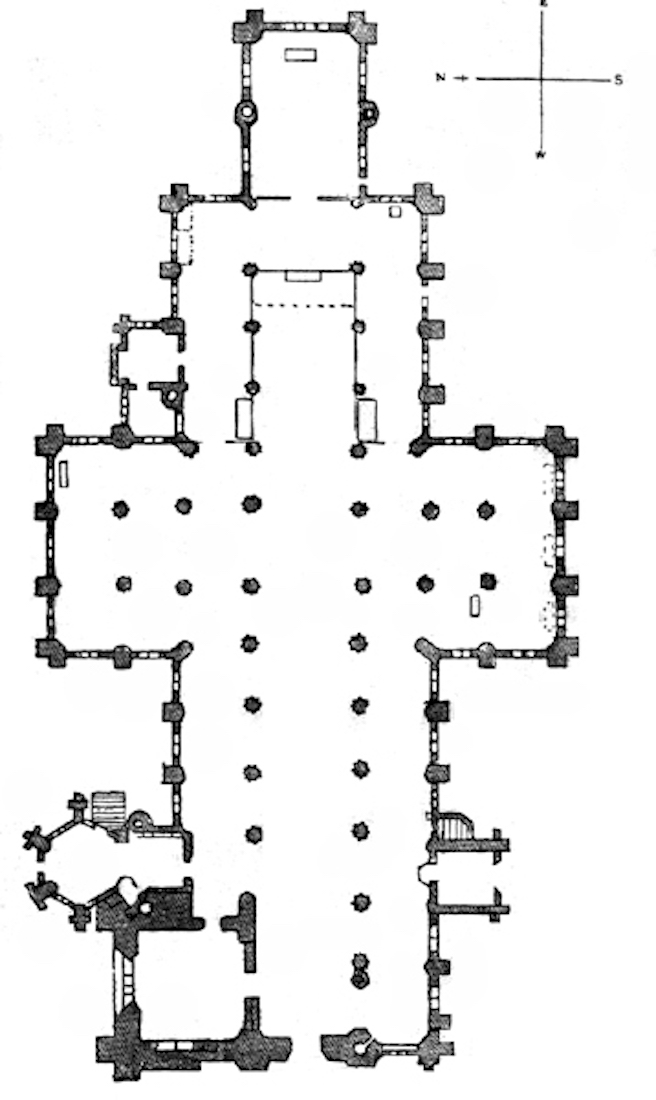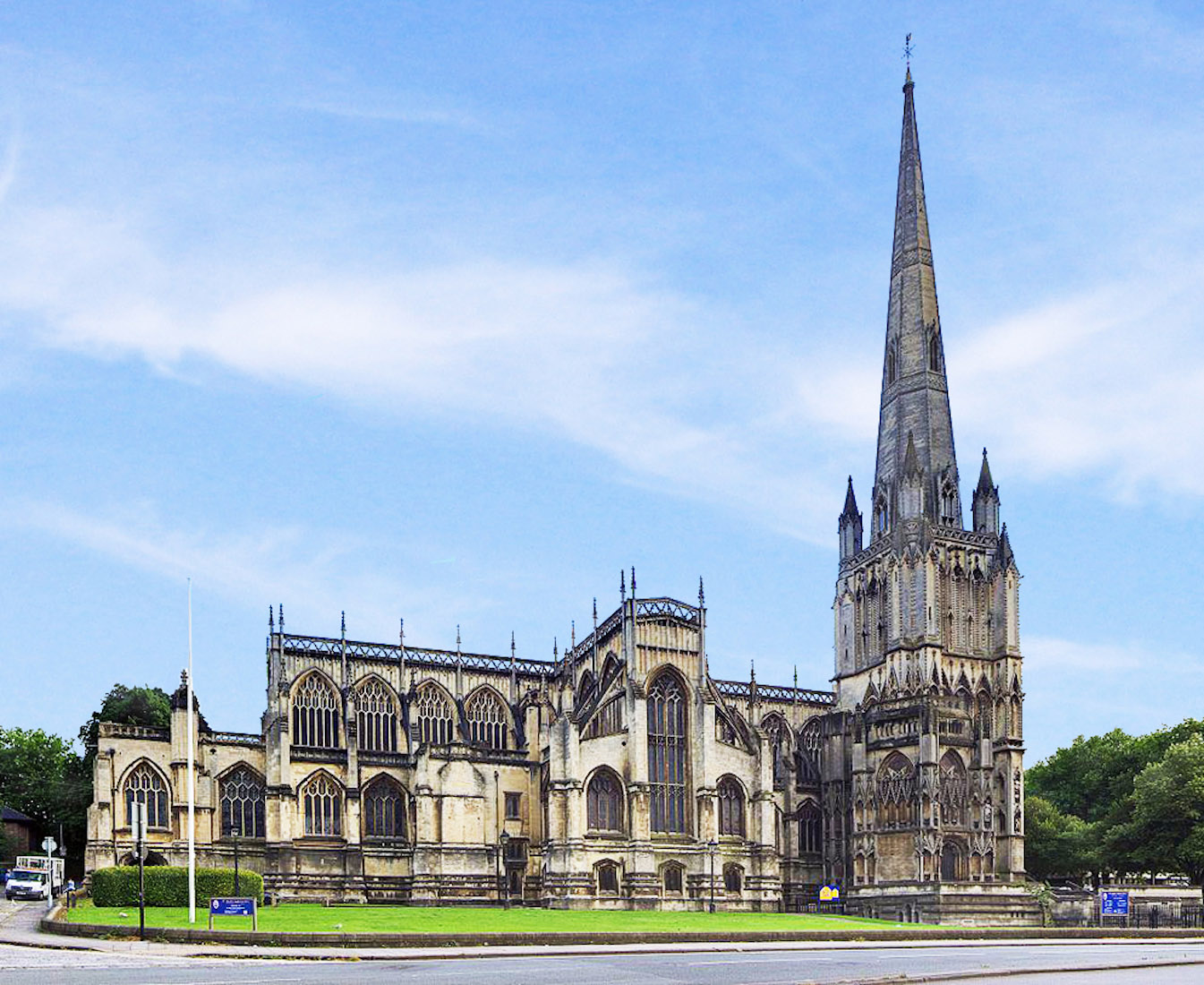ST MARY REDCLIFFE CHURCH
BRISTOL, ENGLAND
PAUL SCOTT

SATELLITE VIEW
St Mary Redcliffe Church is cruciform in shape with a large tower at the western end, and an extended Lady Chapel at the Eastern end. As the axis of the Church is almost exactly due East-West, we can take geographical and liturgical directions as coinciding.
We shall begin our exterior tour near the Lady Chapel and walk around the Church in a clockwise direction. We then enter the Church through the North porch (by the tower), and work our way from West to East.

The Church plan is fairly straightforward with both nave and transept having a covered aisle on each side. Under the tower (bottom left) is the Chapel of St John, and just adjacent, the North porch. The South porch is opposite. There are two private Church offices just East of the North transept, and the Lady Chapel extends at the top.
A history of the Church is given below. However, if you want to begin your tour of the Church immediately, tap / click on START . You can also access intermediate points in the tour by a tap / click on the following links:
NOTE ON MAGNIFYING IMAGES
With this website format the images are large enough for most purposes. If there is a need for greater magnification of an image, go to the identical photo on
https://www.flickr.com/photos/paulscottinfo/albums
and use Command - + (Mac) or Windows - + (Windows).
HISTORY
[Wikipedia]
St Mary Redcliffe is an Anglican parish church located in the Redcliffe district of Bristol, England. The church is a short walk from Bristol Temple Meads station. The church building was constructed from the 12th to the 15th centuries, and it has been a place of Christian worship for over 900 years. The church is renowned for the beauty of its Gothic architecture and is classed as a Grade I listed building by Historic England. It was famously described by Queen Elizabeth I as ‘the fairest, goodliest, and most famous parish church in England.’
Little remains of the earliest churches on the site although a little of the fabric has been dated to the 12th century. Much of the current building dates from the late 13th and 14th centuries when it was built and decorated by wealthy merchants of the city whose tomb and monuments decorate the church. The spire fell after being struck by lightning in 1446 and was not rebuilt until 1872. Little of the original stained glass remains following damage in the English Civil War with extensive new glass being added during the Victorian era. The tower contains 14 bells designed for full-circle English-Style change ringing. Other music in the church is provided by several choirs and the Harrison & Harrison organ.
History
The nave of St Mary Redcliffe The first church on this site was built in Saxon times, as the Port of Bristol first began. In medieval times, St Mary Redcliffe, sitting on a red cliff above the River Avon, was a sign to seafarers, who would pray in it at their departure, and give thanks there upon their return. The church was built and beautified by Bristol’s wealthy merchants, who paid to have masses sung for their souls and many of whom are commemorated there.
Parts of the church date from the beginning of the 12th century. Although its plan dates from an earlier period, much of the church as it now stands was built between 1292 and 1370, with the South aisle and transept in the Decorated Gothic of the 13th century and the greater part of the building in the late 14th century Perpendicular. The patrons included Simon de Burton, Mayor of Bristol, and William I Canynges, merchant, five times Mayor of Bristol and three times MP. In the 15th century Canynges’ grandson, the great merchant William II Canynges, also five times Mayor and three times MP, assumed responsibility for bringing the work of the interior to completion and filling the windows with stained glass. In 1446 much of this work was damaged when the spire was struck by lightning, and fell, causing damage to the interior; however the angle of the falling masonry and the extent of the damage is unclear. Although the spire was to remain damaged for the next 400 years, Canynges continued in his commitment to restore and beautify the church. He took Holy Orders after the death of his wife, and is buried in the church. Other families associated with St Mary Redcliffe include the Penns, the Cabots, the Jays, the Ameryks and the Medes.
In 1571, the school that was to become St Mary Redcliffe and Temple School was formed in a chapel in the churchyard. The church and school have remained closely linked in many aspects of their operations.
The 17th century saw the loss of many of the church fittings and much of the stained glass during the Reformation and the English Civil War. During the reign of Queen Anne, and partially funded by her, the interior of St. Mary Redcliffe was refitted in the Baroque style.
Thomas Chatterton, whose father was sexton of St Mary Redcliffe, was born in the house next to the church in 1752. He studied the church records in a room above the south porch, and wrote several works which he attempted to pass as genuine medieval documents. He committed suicide in London at the age of seventeen. In 1795 the church saw the marriages of Samuel Taylor Coleridge to Sara Fricker and Robert Southey to Sara’s sister Elizabeth.
The upper part of the spire, missing since being struck by lightning in 1446, was reconstructed in 1872 to a height of 292 ft (89 m). Funds for the spire rebuilding had been raised by the Canynges Society, the Friends of St Mary Redcliffe, which was formed in 1843. They raised most of the £40,000 needed. The 1 tonne capstone was laid by the Mayor, Mr William Procter Baker, at the top of the scaffolding. Because of the effect of environmental pollution on the Dundry Stone, further repairs to the spire and other stonework were needed in the 1930s. A mobile telecommunication mast is fitted inside the spire.
During the Bristol Blitz in the Second World War a bomb exploded in a nearby street, throwing a rail from the tramway over the houses and into the churchyard of St Mary Redcliffe, where it became embedded in the ground. The rail is left there as a monument. An accompanying memorial plaque reads ‘On Good Friday 11th April this tramline was thrown over the adjoining houses by a high explosive bomb which fell on Redcliffe Hill. It is left to remind us how narrowly the church escaped destruction in the war 1939-45.’
https://en.wikipedia.org/wiki/St_Mary_Redcliffe


